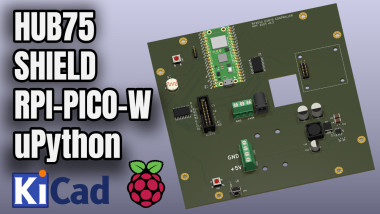Rpi Pico Controlled Matrix Display - Hub75 Style
About the project
The project is a Raspberry Pi Pico shield for RGB LED matrix displays using the HUB75 interface. The RPi Pico is controlled by Micro Python code, one use case is a YouTube subscriber button inclding sound
Project info
Difficulty: Moderate
Platforms: Adafruit, Arduino, MicroPython, KiCad, PCBWay
Estimated time: 4 hours
License: Creative Commons Attribution-ShareAlike CC BY-SA version 4.0 or later (CC BY-SA 4+)
Items used in this project
Story
I made this shield because i wanted to improve my KiCad skills and i was also very curious about how i could make a project using micro python.
I have a small amount of knowledge about using Kicad since i have been using Orcad and Altium Designer for all my preious projects. I am very impressed about the free KiCad suite which now has been released in version 8.0 - i look forward to make more projects using this tool in the future.
Its very easy to get started witch micro python, i am using Thonny and there is a lot of recources on the internet about how to get started.
The shield is pretty forward, the main controller is an Raspberry Pi Pico W. The signals for the HUB75 interface is level shifted to 5V using some standard octal buffers type 74HCT245. There is also a pinheader for an I2S controlled speaker, which is made on a seperate board. Its possible to adjust the intensity of the light on the display by measuring the ambient light using a LDR conneted to an ADC port on the RPi Pico W.
The powersupply is made using the buck converter TPS5430/TPS5450 for Texas Instruments. This converter can handle up to +24V and deliver 5V at either max 3A or 5A which is enough for most projects.
Please check out more details in the YouTube video or send me a question if you need further details.
All code and design files for the project can be found in my GitHub repo. Currently my shield is running the YouTube Subscriber counter using an I2S controlled speaker to play tunes when i gain new Subsribers :-)






















Leave your feedback...